Four of the National Motor Museum’s iconic Land Speed Record cars, the 350hp and 1,000hp Sunbeams, Golden Arrow and Bluebird CN7, which reflect the success of British record-breakers between the 1920s and 1960s, feature in an inspiring new multi-media display For Britain & For The Hell Of It, opened yesterday (20th March) by Don Wales, grandson of Sir Malcolm Campbell.
In opening the display Mr Wales said: “The 116 year history of Land Speed Records has been dominated by the British. The record has been broken 57 times, 26 by a Briton and 8 by a Campbell. My uncle, Donald, broke the Land and Sea record in the same year – a unique double that has never been equalled. British Land Speed Record cars are an important part of our heritage and need to be on show for the public to see. It is also vital that the skills required to keep them going is kept alive.”
British drivers, engineers, mechanics and cars have broken the World Land Speed Record more times than any other nationality. Their story is brought to life in a moving audio-visual presentation, accompanied by items from the museum’s Collections, on public display for the first time. Exhibits include contemporary souvenirs and memorabilia, trophies and personal items belonging to the drivers. The display transports you back to a time of invention, courage and patriotism and also introduces you to those who are keeping Britain’s record breaking dream alive today.
In the 1920s, the 350hp Sunbeam – a new kind of car for a new era – was the first powered by an aero engine. Its drivers too, were men of the age – Kenelm Lee Guinness, who took the record in 1922, and Capt. Malcolm Campbell who, having remodelled the car several times, flew through the record twice, breaking the 150mph barrier in 1925 at Pendine Sands, Wales. In the dawn of a golden age of speed, the Brits had truly arrived.
As the 1920s accelerated, so did the speed and the 1,000hp Sunbeam really made the Twenties roar. At the wheel, sandwiched between the front and rear engines, Major Henry Segrave cruised through 200mph at Daytona Beach, Florida – the first person ever to travel at that speed on land.
In 1929 the iconic blend of style and engineering in the Irving Napier Special, Golden Arrow, with its distinctive engine shape, paved the way for two decades of unbroken British success. At 231.446mph, with Segrave again in the driving seat, this arrow shattered its target.
In 1964, a new Campbell – Donald – son of Malcolm, set the record in Bluebird CN7. A first record attempt at Bonneville in 1960 met with disaster when Bluebird, caught by a gust of wind, veered off course and somersaulted. With Bluebird re-built and a tailfin added for stability, his last attempt on the record, at Lake Eyre, Australia, propelled a triumphant Campbell through the elusive 400 to claim the official wheel-driven record for Britain at 403.10mph.
An unofficial record of 407mph set by Craig Breedlove in a jet powered car the previous year was against International rules. However, Breedlove’s faster jet-car run had proved that the old rules would have to be rewritten. It was the end of a glorious era for the Campbells, Bluebird cars and for Britain.
While, over succeeding decades, new records have continued to be set, a reviving interest in electric, steam and alternative fuel records has been growing. Accompanying the Land Speed Record display, the museum’s new exhibition of alternative Land Speed vehicles includes the nitromethane fuelled Commuter Dragster, the very first All American fuel Dragster to be built and run in Britain and the first to break the magic 200mph barrier over the standing start quarter mile. Also displayed are the Bluebird Electric, in which Don Wales set a new speed record for an electric car of 137.15mph at Pendine Sands in 2000 and the British Steam Car Inspiration – the fastest ‘kettle’ in the world – in which he achieved 139.843mph at Edwards Air Force base, California, in 2009.
Speaking on behalf of his father, Lord Montagu, the Hon Ralph Montagu said: “It is very fitting that we are opening the display this year as 2014 celebrates the 85th anniversary of Henry Segrave setting a new world Land Speed Record in Golden Arrow in 1929. And fifty years ago, in 1964, Donald Campbell achieved over 400mph in Bluebird CN7 at Lake Eyre.”
The Land Speed Record display and exhibition is now open and can be seen as part of a visit to the whole Beaulieu attraction, which includes the National Motor Museum, World of Top Gear, Beaulieu Abbey, Palace House and gardens.
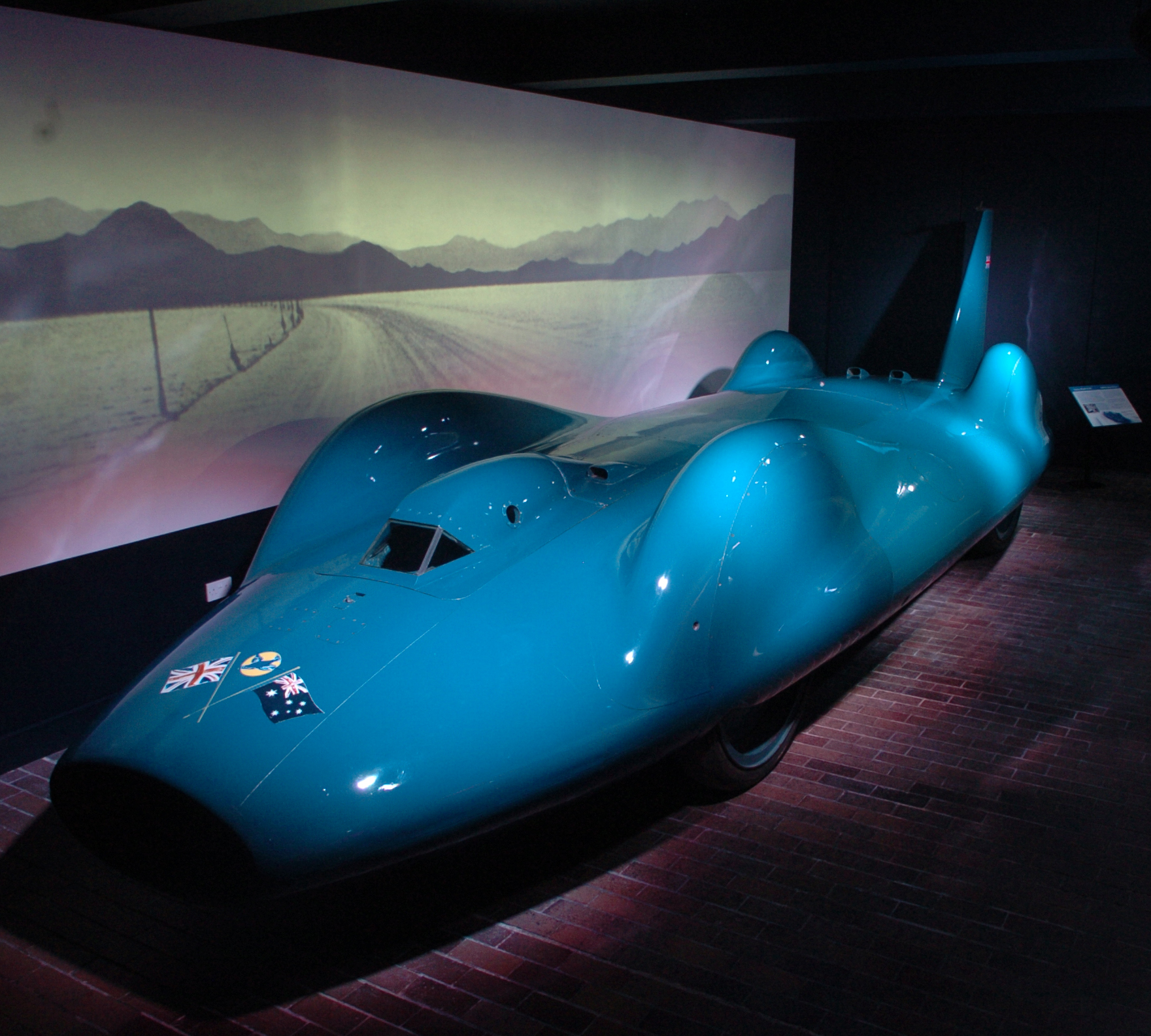
Bluebird CN7
The first car to officially set a Land Speed Record in excess of 400 mph and the last to be wheel driven,Bluebird CN7 was one of a long line of speed machines associated with the Campbell family.
Donald Campbell already held the Water Speed Record. His goal was 400mph on land. Technical support and backing came from British industry. Designed by Ken and Lew Norris, Bluebird CN7 was powered by a Bristol-Siddeley Proteus gas turbine engine, as used in jet airliners, driving all four wheels. It was a massive and expensive project, costing an estimated £1,000,000 to build.
Vehicle Information
- Engine: Bristol-Siddeley Proteus gas-turbine, 4,100 shaft hp at 11,000fpm
- Performance: 403.10mph
- Manufacturer: Motor Panels Ltd, Coventry
- Owner: Science Museum
Records Held
A first record attempt at Bonneville in 1960 met with disaster when Bluebird, caught by a gust of wind, veered off course and somersaulted. Campbell escaped with minor injuries but the car was virtually destroyed. The project was revived and Bluebird rebuilt, this time with a distinctive high tail to aid stability. A new venue was found at Lake Eyre in South Australia. Bad weather meant that record attempts in 1962 and 1963 had to be abandoned.
17th July 1964: Eventually, despite mechanical problems and unpredictable weather, a speed of 403.10mph was attained.
Campbell’s record was short lived. Rule changes meant jet propelled cars were now accepted. By the end of 1964 the record had been broken five times and was 133mph faster.
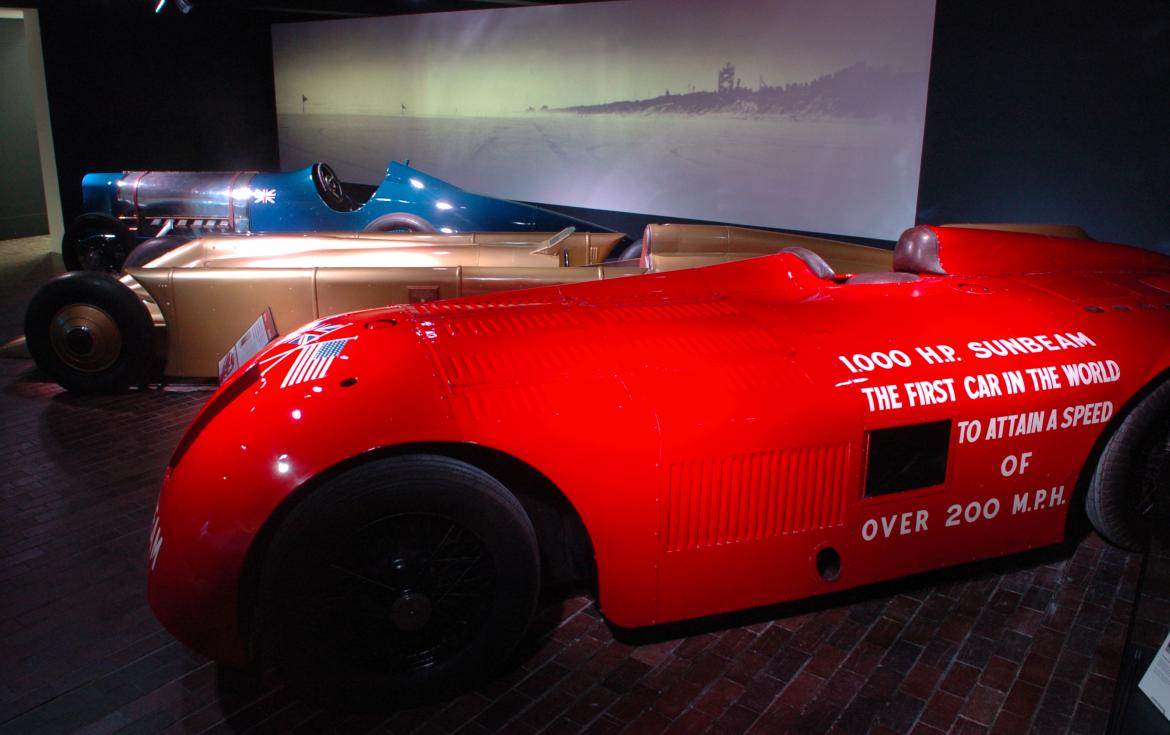
Sunbeam 1000hp
The impressive 1,000hp Sunbeam was one of the first purpose built Land Speed Record cars and the first to reach 200mph. The driver was Major Henry Segrave, a previous record holder at the wheel of a 4 Litre Sunbeam at Southport in March 1926.
The concept for the car came from Sunbeam’s Chief Engineer, Louis Coatalen, with detailed design work by Captain J S Irving. Power was from two 22.5 Litre V12 Matabele aero engines, each delivering 435bhp. These were positioned in line, with the driver’s cockpit in between. Transmission was via a three-speed gearbox, driveshaft and chains. Actual power output was around 900hp but the 1,000hp title probably appealed to Sunbeam’s directors.
Vehicle Information
- Engine: 2 x 22,444cc V12, overhead camshaft, 435bhp at 2,000rpm
- Performance: 207.015mph
- Manufacturer: Sunbeam Motor Co. Wolverhampton
- Owner: Montagu Collection
Records Held
It was estimated that a venue at least nine miles long would be needed to reach 200mph. With nowhere suitable in Europe, Segrave chose Daytona Beach in Florida. The car was largely untested when it arrived in the USA in early March 1927.
29th March 1927: During the first of the two runs the wind caused the car to swerve and skid violently with Segrave having to drive the car into the sea to slow it down. The speeds achieved were 200.668mph and 207.015mph, giving an average speed of 203.792mph and a new Land Speed Record.
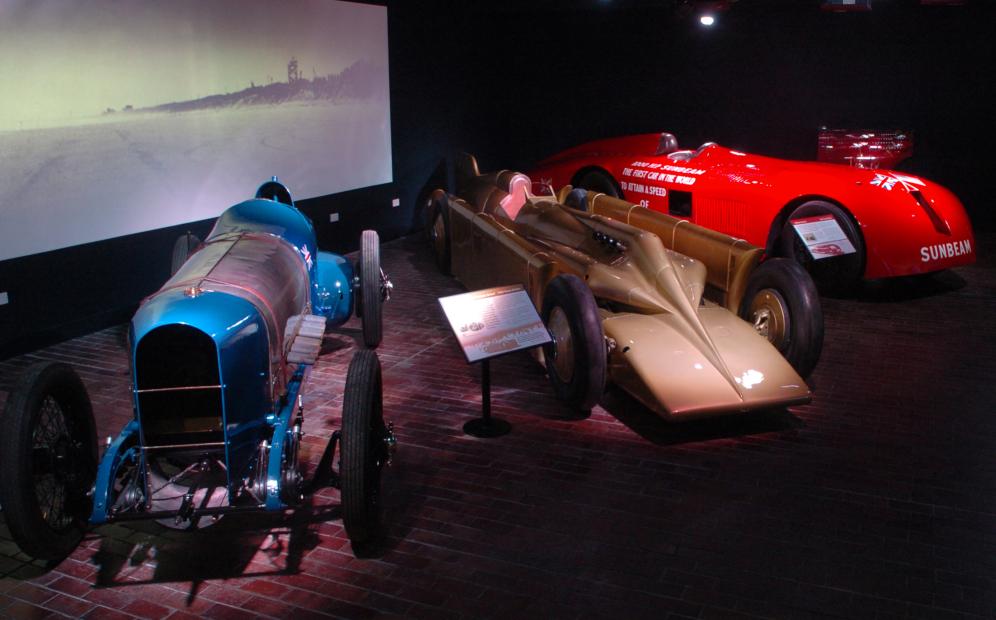
Irving-Napier Special ‘Golden Arrow’
Golden Arrow was Major Henry Segrave’s answer to a renewed overseas challenge to British Land Speed Record supremacy. In 1927 Segrave had been the first man to exceed 200mph on land. Malcolm Campbell raised the record to 206.956mph in February 1928, only to have America’s Ray Keech exceed this by 0.5mph a month later in the ‘Triplex Special’. Segrave was determined to retake the record for Britain.
Officially named the Irving-Napier Special, Golden Arrow was designed by Captain J S Irving. It was built in the KLG Spark Plugs factory in West London with support from many leading British companies. Power came from a Napier W12 Lion aero engine as used in Supermarine Schneider Trophy seaplanes. Irving hoped that Golden Arrow would be capable of 250mph.
Vehicle Information
- Engine: 23,900cc, W12, overhead camshaft, 925bhp at 3,300rpm
- Performance: 231.446mph
- Manufacturer: KLG Robin Hood Works, Putney Vale, London
- Owner: Montagu Collection
Records Held
Golden Arrow was shipped to Daytona in February 1929 where Segrave made two 180mph test runs.
11th March 1929: Segrave made his two timed runs through the measured mile; 15.55 seconds on the first run, 15.57 on the second on Daytona Beach. The speed of 231.446mph exceeded Keech’s record by 24mph.
The following day an attempt to re-take the record for the USA ended in tragedy when the ‘Triplex Special’, this time driven by Lee Bible, skidded, killing both the driver and a film cameraman.
Vehicles using alternative sources of power, such as steam and electricity, have also broken Land Speed Records. We are pleased to include some great examples of these record challengers in our new display.
Electric Drag Bike – holder of the Alternative Energy Racing record
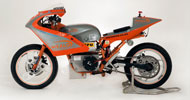 A love of technology, experience in engineering and manufacturing and a motorcycle restoration hobby led Phil Edwards of Weald Technology to develop and build anelectric bike. With a self-funded budget of £10,000 he set about breaking theAlternative Energy Racing record of a standing quarter mile of 14.9989 seconds, held then by Kingston University.
A love of technology, experience in engineering and manufacturing and a motorcycle restoration hobby led Phil Edwards of Weald Technology to develop and build anelectric bike. With a self-funded budget of £10,000 he set about breaking theAlternative Energy Racing record of a standing quarter mile of 14.9989 seconds, held then by Kingston University.
The record was broken on 14th May 2011 at Santa Pod. Experienced racer Rob Moon recorded 14.33 seconds on his first run, a new UK record. After some adjustment work by the team a new record was set at 14.12 seconds, an average speed of 96.5mph.
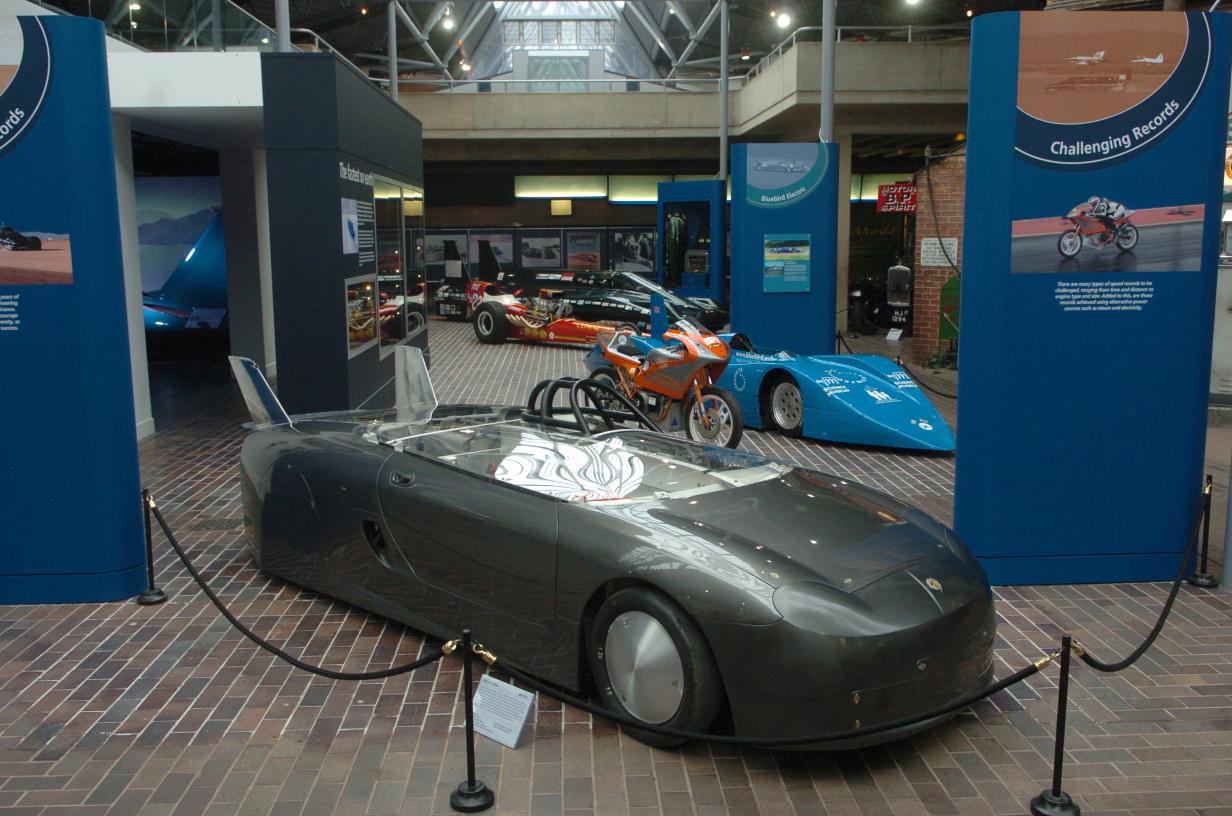
MG EX 255 Record Car (1998) – attempted to be the fastest MG
Innovative design, specialised engineering and the desire to break Phil Hill’s 1959 record speed of 254.91mph in streamliner EX 181 – the fastest MG ever, combined to produce the EX 255.
At Bonneville in 1998, Land Speed Record holder, Andy Green, was chosen to drive EX 255 but his attempt was thwarted by problems with the car’s supercharger. The team returned to Bonneville in 1999 with a more reliable twin turbocharger unit but, unfortunately, clutch problems meant that the record attempt ran out of time.
Bluebird Electric – UK Speed record for an electric car
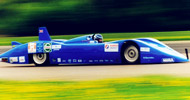 On the 20th August 2000, Bluebird Electric set a new UK Speed Record for an electric car of 137.15mph (220kph), at Pendine Sands in Wales. It was driven byDon Wales, the nephew of Donald Campbell and grandson of Sir Malcolm Campbell.
On the 20th August 2000, Bluebird Electric set a new UK Speed Record for an electric car of 137.15mph (220kph), at Pendine Sands in Wales. It was driven byDon Wales, the nephew of Donald Campbell and grandson of Sir Malcolm Campbell.
In 2011, Don and the Bluebird Electric team attempted to break that record again at Pendine Sands with a new improved version of Bluebird Electric. Sadly, they were unsuccessful as the car suffered a mechanical failure but they continue to strive to achieve this aim and to take the UK record beyond 150mph.
The Commuter Dragster – British Land Speed Flying Start kilometre record
 The Commuter was the very first AA (All American)/Fuel Dragster (fuelled by nitromethane rather than gasoline) to be built and run in Britain and the first to break the magic 200mph barrier over the standing start quarter mile.
The Commuter was the very first AA (All American)/Fuel Dragster (fuelled by nitromethane rather than gasoline) to be built and run in Britain and the first to break the magic 200mph barrier over the standing start quarter mile.
During the summer of 1970 the car was extensively modified from its quarter mile set up. On Saturday 3rd October 1970, Commuter, driven by Tony Densham, broke the official British Land Speed Record for a wheel driven vehicle when he achieved a two way average speed of 207.4 mph over the flying start km at Elvington, York. Today this record remains unbroken. The previous record, held by Sir Malcolm Campbell at 174.88 mph, had stood for 43 years.
British Steam Car – Steam land speed record
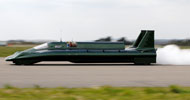 A Land Speed Record of 127mph, the first over 100mph, was set in 1906 by American, Fred Marriott, in his car, ‘Rocket’. This, in itself, was a considerable achievement but, remarkably, ‘Rocket’ was a steam car. Although soon beaten by petrol engine cars it would remain the fastest steam powered car in the world for over a century.
A Land Speed Record of 127mph, the first over 100mph, was set in 1906 by American, Fred Marriott, in his car, ‘Rocket’. This, in itself, was a considerable achievement but, remarkably, ‘Rocket’ was a steam car. Although soon beaten by petrol engine cars it would remain the fastest steam powered car in the world for over a century.
The vehicle that broke Marriott’s record is the British Steam Car Challenge ‘Inspiration’. On 25th August 2009, in California, Charles Burnett III piloted Inspiration to an average speed of 139.843mph (225 km/h) securing a new international steam Land Speed Record. The next day Don Wales, grandson of Sir Malcolm Campbell went even faster, breaking the American record of an average measured mile with a speed of 148.166mph.
